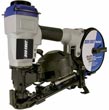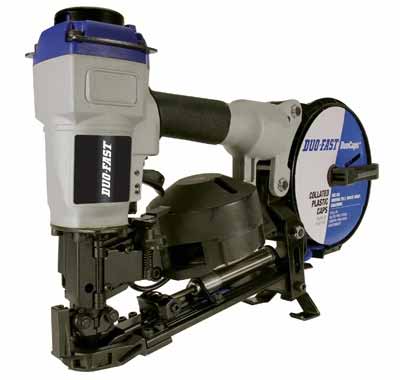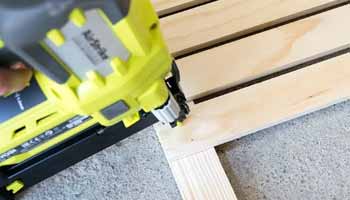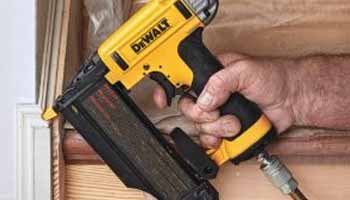It costs you 5351 to 10830 dollars to install or replace your roof. Those are quite substantial figures if you asked me. The good news is that keeping the cost as low as possible is not beyond your reach.
If you have some handy skills, you may opt to mount the roof yourself and save on labor.
With the right materials and the best cap nailer, you can easily install or repair your own roof.
A good cap nailer is great for installing roofing felt, wraps, and underlayment. Moreover, you can utilize it to mount upholstery.
The benefit of using this machine is that the connection is more secure, thanks to the extended surface area of the nail head. Furthermore, the cap creates a better water seal than a standard nail.
Go through the review below to find a cap nail gun that will serve your needs efficiently.
Image | Name | Editor's Rating | Price |
|---|---|---|---|
Bostitch Model N66BC-1 | 5 out of 5 | ||
Cn100 Stinger Cap Nailer | 5 out of 5 | ||
 | Duo Fast DCR175-CN Cap Nailer | 4 out of 5 |
Our Recommended Best Cap Nailer in 2020
1. Bostitch Model N66BC-1

In the world of fastening tools, Stanley Bostitch is undoubtedly one of the top brands. Selling a wide assortment of guns and compressors, Bostitch is known for the remarkable quality of its products.
For those seeking the best cap nailer, the Bostitch Model N66BC-1 is a great unit to check out. With 500 pounds of driving force at 100 psi, this machine has what it takes to put nails in hard materials efficiently.
It takes no time to plow nails through 1-inch boards. Actually, if you’re looking for a nailer that will help you finish the task speedily, this is it. Thanks to its power, the Bostitch Model N66BC-1 lets you drive up to 2.5-inch long nails.
Saying the build quality of this machine blew me away is an understatement. The tool features the most amazing construction of any cap nailer. It is made of magnesium, which allows it to stand up to abuse while being adequately lightweight.
This is the sort of tool you want to use on your roof as carrying it will not be a huge bother.
With the Bostitch Model N66BC-1, you don’t have to keep reloading. The tool stores up to 300 nails on its coil and up to 100 caps.
For each coil of 300 nails, you only have to give the gun a cap refill 3 times.
There is lots of convenience in fewer reloads in terms of the less effort needed and the time saved.
Using this gun, you don’t need to keep adjusting the pressure of your compressor to match the needed nail depth. That is because the unit features a dial that lets you adjust the nail depth conveniently.
Finally, it features an adjustable exhaust. That allows you to change the direction of the air to prevent it from blowing into your face when you’re working.
Highlighted Features:2. Cn100 Stinger Cap Nailer

Stinger has been around for quite a while, being one of the top sellers of quality nail guns. If you want a model that lives up to its name, the Cn100 Stinger Cap Nailer is a good one to consider.
The problem with most cap nailers out there is that they’re either too heavy or they have to be reloaded too many times. Some even come with both issues.
If you’re serious about avoiding these problems, look in the direction of the Cn100. This model weighs in at 4.9 pounds, which is pretty lightweight for a cap nail gun.
The unit has a nail capacity of 200, meaning you don’t have to keep reloading the nails. If you’re working on the roof and don’t want to keep climbing up and down the ladder, the capacity will come in handy.
You know what is even more amazing? The fact that the cap capacity is also 200. Once you load a coil, you get to finish fastening all the nails without needing to reload the caps. Isn’t that cool?
With regard to speed, this is straight out the best model of a cap nailer. Its cycle rate maxes out at 5 nails per second, giving you the chance to finish the project speedily.
Whether you’re a beginner or an experienced in working with nailers, this unit is suited for you. It comes with the bump firing mode for speed. There’s also a sequential firing option for safety, which is fit for beginners.
Don’t worry about gas getting shot into your face. The 360-degree rotatable exhaust is there to help you put the gas out of the way.
Highlighted Features:3. Duo Fast DCR175-CN Cap Nailer

Looking for a powerful cap nailer but don’t want to spend big bucks on it? The DCR175-CN Cap Nailer from Duo Fast goes easy on your wallet without compromising on quality.
Installing sidewall and roofing materials with this unit is absolutely easy. Working with pressures ranging from 90 to 120 psi, the machine is able to drive fasteners that are between 7/8 and 1 ¾ inches.
I was so impressed by the tool’s in-line design, which makes it well-balanced and extremely easy to control.
That, coupled with the fact that the tool is not bulky for a coil and cap nailer, makes the Duo Fast absolutely suitable for DIYers. This is the kind of tool that doesn’t leave you exhausted after hours of working on the roof.
Don’t want to keep reloading the caps? You can load up to 240 caps, meaning there are fewer reloads to deal with. The machine holds up to 120 plastic collated nails.
Yet another feature that makes this model so attractive is the nail only function. At the top of the tool, there is a button that allows you to turn off the caps. That makes the unit versatile, suitable for cap, and standard nailing.
Like any worthy pneumatic nailer, the Duo Fast DCR175-CN lets you change the direction of the air coming from the exhaust. That is made possible by the 360-degree adjustability.
Highlighted Features:Cap Nailer Buying Guide
Buying a cap nailer is an important decision. While at it, you need to realize that these machines don’t work the same. Factors such as nail size, nail/cap capacity, and more vary from model to model. Then again, the quality also differs.
If you’re shopping for the good quality cap nailer, here are some of the things to consider.
1. Compatible Caps and Nails

Cap nailers differ by the size and number of the caps and nails they can support.
Check the size of nails the nailer can support. You may see something like ¾ inches to 2 inches. Also, find out the size of caps the unit works with. In the description, you might find something like ‘works with 1-inch caps.’
After that, check the number of nails and caps you can load into the machine. Some can hold up to 100 nails while some can hold as many as 300. Remember, the higher the number, the fewer the times you will need to reload.
2. Size and Weight
The size and weight of the nail gun will determine the ease of maneuvering the device. As a DIYer, the last thing you need is something bulky and heavy. What you need is a machine that allows you to move easily and which doesn’t leave you fatigued after long durations of nailing.
Pay attention to the size of the nailer and watch the weight too. For ease of handling, the unit’s weight shouldn’t exceed 5 pounds.
3. Depth Adjustment
While using a nailer, one of the crucial factors you have to mull over is the depth of drive. Depending on the material and thickness of what you’re nailing, you will want the nail to sink only to a certain extent. And to avoid either overdriving or underdriving the nail, you have to control the depth of drive.
If your nailer doesn’t come with the tool-free depth of drive adjustment feature, then you will need to keep changing the pressure of the compressor. That is not convenient, so it is advisable to get a gun with the depth adjustment feature.
4. Adjustable Exhaust
Imagine the exhaust blasting the gas in your face when nailing. It's not a good situation, is it? Thankfully, some models come with an adjustable exhaust. By rotating the exhaust to a different position, you're able to shift the gas and prevent it from blowing into your face.
While that is a feature you can pass on to save money, it is rather essential to have it.
3. Firing Mode
There are two basic firing modes – the bump/contact mode and the sequential firing mode.
The one you use should depend on your needs, especially experience and the time you have to complete the project.
Bump firing allows you to nail quickly but it is less safe. Therefore, it is suited for experienced users.
Sequential firing offers less speed but it is safer. For beginners, it is the right mode.
I’d advise you to go for a nailer that comes with interchangeable firing modes, so you can always use the mode that suits your needs.
People Also Asked:
1. What’s the Benefit of using Cap Nailer?
Ans: While a standard nailer drives the nail alone, a cap nailer drives the nail with a cap at the head. The cap increases the surface area of the head, thus securing the nail better. Moreover, the cap holds the material being nailed, thereby preventing it from tearing or cracking.
2. When Can I Use a Cap Nailer?

Ans: Any time you want to secure a soft or dense material, a cap nailer might be the best option. It is often used to secure roof underlayment, house wraps, and felt. You can also use it to attach upholstery to furniture to give it a more secure hold.
3. Which One Between Standard Nails and Cap Nails is Better for Roofing?
Ans: When you nail the roof, you create holes that can give entry to rainwater. A nailing method that allows you to cover the holes as much as possible would be incredibly helpful, helping you avoid leaks and protect your roofing materials from water-damage.
That method is the cap nailing method. The caps create a better seal that keeps the water from entering a lot more reliably than a plain nail head.
4. Should I Hand-Nail My Roofing Shingles?
Ans: Hand nailing shingles is a time-consuming and rather exhausting process. If the wood is intact, it is a lot better to use a nailer for the speed, accuracy, and ease of use offered. You should only hand-nail when dealing with damaged wood.
Final Word
If you’re looking to install your roof fast and securely, the best cap nailer will come in handy. This machine is incredibly useful, allowing you to create water-tight connection points. When the rain or snow comes, the cap nail design will protect your roofing materials reliably, making them last longer.
When looking for the right nailer, be sure to keep in mind the factors I talked about in the buying guide. Pay attention to the size of nails and caps supported and the nail and cap capacity.
Aside from that, factors such as depth adjustability, exhaust adjustability, and firing mode will determine the sort of experience you have when using your nailer.
It is my absolute conviction that with any of the models in the review, installing or replacing your roof will be a breeze.
- How to Choose Wood Filament: A Complete Guide - July 17, 2021
- 10 Best Propane Forge Reviews - June 30, 2021
- Best Circular Saw Blade for Plywood : Top 10 Picks - June 30, 2021


